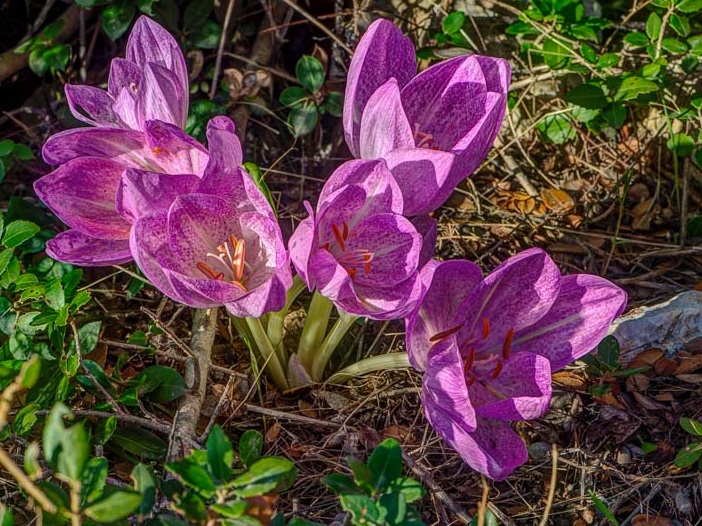Bivona's meadow saffron
(Colchicum bivonae)

Description
Colchicum bivonae is a perennial bulbous plant belonging to the Colchicaceae family. It is commonly known as Bivona's meadow saffron and is native to the Mediterranean region, particularly in Italy, Greece, and Turkey. Description Colchicum bivonae typically grows up to 10-15 cm tall, with slender, erect, and hairless stems emerging from underground bulbs. The leaves are basal, strap-shaped, and up to 25 cm long and 2 cm wide, and they emerge in the fall after the flowers have bloomed. The flowers are usually a deep mauve or purple, occasionally white, and have a long, slender tube up to 8 cm long, which flares out to form six pointed petals. Habitat and Distribution Colchicum bivonae is commonly found in meadows, rocky slopes, and open woodlands, where it thrives in well-draining, humus-rich soil. Its native range extends from southern Italy, Sicily, Greece, and Turkey, but it has also been naturalized in other parts of Europe. Cultivation Colchicum bivonae is a popular ornamental plant due to its showy autumn flowers. It is easy to cultivate in the garden or in pots, provided the soil is well-drained and slightly alkaline. The bulbs should be planted in the summer, about 10-15 cm deep, with a spacing of 10-15 cm between bulbs. The plant requires full sun to partial shade and regular watering, particularly during the growing season. Propagation Colchicum bivonae can be propagated by dividing the bulbs in the summer after the leaves have died back. The new bulbs should be planted immediately in a well-draining, humus-rich soil. Uses Colchicum bivonae has been used in traditional medicine for its anti-inflammatory and pain-relieving properties. It contains the alkaloid colchicine, which is used in modern medicine to treat gout, rheumatoid arthritis, and other inflammatory conditions. However, it is important to note that colchicine is toxic in high doses and should only be used under medical supervision. In addition to its medicinal properties, Colchicum bivonae is also used in horticulture as an ornamental plant. Its vibrant autumn flowers provide a splash of color in the garden and can be used in floral arrangements. Conservation Colchicum bivonae is not considered endangered, but its natural habitat is threatened by habitat destruction, particularly from urbanization and agricultural expansion. It is important to conserve the species and its habitat to maintain its ecological and cultural value. Conclusion Colchicum bivonae is a beautiful and versatile plant that has both medicinal and ornamental value. As a member of the Colchicaceae family, it contains the toxic alkaloid colchicine, which has both therapeutic and toxic effects. Therefore, it should be used with caution and under medical supervision. With proper cultivation and conservation measures, Colchicum bivonae can continue to thrive in gardens and natural habitats around the world.
Taxonomic tree:







